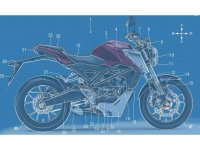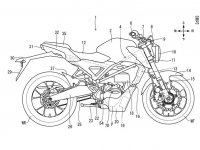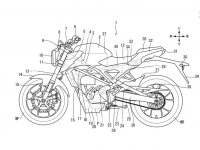Nothing is for sure. But patents have been filed.
Unlike most of the electric motorcycles like the $30,000 HD Livewire and the expensive ZERO motorcycles, the Honda, based on the popular (worldwide) CB300 chassis, is actually based on low cost and possibly even practicality.
ALL e-motorcycles suffer from the same issue, a lack of range and long re-charge times (45min to several hours) plus a high cost. So e-motorcylces are pretty much short range commuter machines. Not saying you can't do cross-country trips, because people have done that, with carefully planned routes that follow charging stations. But if you want to explore backroads, its not going to be an easy task. HONDA's potential offering does not look to have solved that problem.
On the other hand, by using existing frames and technologies, plus high volume production, HONDA may be the first to offer an e-motorcycle that is cost effective and has a wide dealer network for parts and support. Given that the very popular CB 300 is a sub $5000 machine, one can hope that an e-version of the bike would not be offered at too high of a premium so perhaps a $6500 electric machine that would make for a nice city/suburban commuter bike? A price south of $7500 in a practical package would send a powerful signal to the motorcycle world where electric powered machines make up a tiny fraction of a percentage of the sales. While the America market may not find a lot of interested customers, its probably a pretty safe bet that Asian, Indian and European markets, where small motorcycles dominate sales, may find favor in something like this.
LINK --> https://www.cycleworld.com/story/bikes/honda-cb-electric-preview/
Unlike most of the electric motorcycles like the $30,000 HD Livewire and the expensive ZERO motorcycles, the Honda, based on the popular (worldwide) CB300 chassis, is actually based on low cost and possibly even practicality.
ALL e-motorcycles suffer from the same issue, a lack of range and long re-charge times (45min to several hours) plus a high cost. So e-motorcylces are pretty much short range commuter machines. Not saying you can't do cross-country trips, because people have done that, with carefully planned routes that follow charging stations. But if you want to explore backroads, its not going to be an easy task. HONDA's potential offering does not look to have solved that problem.
On the other hand, by using existing frames and technologies, plus high volume production, HONDA may be the first to offer an e-motorcycle that is cost effective and has a wide dealer network for parts and support. Given that the very popular CB 300 is a sub $5000 machine, one can hope that an e-version of the bike would not be offered at too high of a premium so perhaps a $6500 electric machine that would make for a nice city/suburban commuter bike? A price south of $7500 in a practical package would send a powerful signal to the motorcycle world where electric powered machines make up a tiny fraction of a percentage of the sales. While the America market may not find a lot of interested customers, its probably a pretty safe bet that Asian, Indian and European markets, where small motorcycles dominate sales, may find favor in something like this.
LINK --> https://www.cycleworld.com/story/bikes/honda-cb-electric-preview/
Love them or loathe them, there’s no question that electric motorcycles are coming. Major manufacturers are now simply biding their time until the equation of costs and sales in the electric bike market tips in favor of profit before diving headlong into the fray. That moment seems to have taken a step closer with the emergence of Honda patents showing the firm working on an electric motorcycle based on existing components. The design isn’t radical, and that’s its strength. Instead of trying to woo early adopters with whizbang technology, Honda is developing a machine that wouldn’t look out of place in a showroom right now.
Honda’s patents show that the bike is simply an electric-powered version of the existing CB125R and CB300R—the smallest models in the firm’s Neo-Sports Café range, with styling to match the CB1000R and CB650R. It shares the CB’s frame, styling, suspension, wheels, and brakes, but switches the original four-stroke single for an electric motor.
That might not sound like a recipe for success in the face of purpose-developed electric motorcycles like Harley’s LiveWire or Zero’s range, but from an economic and production point of view it’s a stroke of genius. Honda already turns these chassis components out in vast numbers, selling bikes based on the parts in most territories including India as well as Europe, the USA, and Japan. The combination of the economy of scale achieved by reusing existing parts and the reduced R&D spend—with the firm only needing to create an electric powertrain, not an entire bike—means a more cost-effective solution for both Honda and the consumer. What’s more, by creating a motor that bolts straight into the place of the current 125cc and 300cc singles Honda could reuse the same package on a variety of models. If it works in the CB chassis, it should slot just as easily into the Rebel 300 or CRF250L frame.
The electric motor itself isn’t radical either. It’s an oil-cooled unit that drives the rear wheel via a simple reduction gearset and final drive chain. There’s no complex, multispeed transmission, no clutch, and no water-cooling, so the unit can be kept as small and self-contained as possible. As a result the motor and reduction gears slot into the space where we’re used to seeing the bike engine’s bottom end and transmission. The only plumbing required is a couple of oil lines to a cooler mounted where you’d normally find the radiator, and wiring to a control unit that sits above the motor—filling the spot where you’d find the cylinder head of a CB125R or CB300R. Given that the control unit on the final bike is likely to be an aluminum box with cooling fins, the appearance should be conventional enough to pass for a gas-powered bike until you look closely.
Honda’s patents concentrate on the cooling system and ways to make the motor and reduction gears narrow enough to fit in the existing frame—a good indication that the existing CB components haven’t been used merely as placeholders in the design drawings. They show that while the fuel tank area looks the same as the gas-powered machines, it’s actually a dummy cover—Honda calls it a “knee grip”—to hide the batteries. One high-voltage battery is under the “tank” and another is under the seat, while a low-voltage battery to run the 12V systems on the bike is mounted just ahead of the electric motor, hidden in a vestigial bellypan. It’s not clear whether the high-voltage batteries are intended to be swappable, but it would make sense for Honda to use the same hot-swap units that it already uses in the PCX Electric scooter.
The PCX Electric actually gives a good insight into Honda’s thinking for the new design. Like the CB seen in the patents, it’s based on an existing gas-powered model and shares as many mass-produced components as possible to reduce production cost and complexity.
It also demonstrates that Honda’s invasion into the world of electric bikes is mimicking the progress the firm made in its first forays into international mass-market success on both two wheels and four. Instead of jumping straight into the high-end, high-performance market, it started with small, cheap, friendly machines—the Cub on two wheels and the Civic on four—to gain a strong following before turning its attention to more ambitious projects. It’s a smart move; hardcore enthusiasts tend to be more stuck in their ways than casual buyers, and starting with small machines takes away pressure to compete with the very best in terms of performance and range, putting the emphasis on price and practicality instead.
Speaking of performance, using a 125cc number as its basis suggests that’s the market Honda is aiming the new design at. That means around 15 hp—the limit for learner riders in Europe—though since electric motors are measured for maximum “continuous” performance rather than absolute output, it could still hit short-term peaks of twice that much without falling foul of any legal power restrictions. In cities and between the lights, a cheap, lightweight electric bike with unchallenging, attractive styling and a conventional feel could be the perfect solution for many riders, both existing and new.





